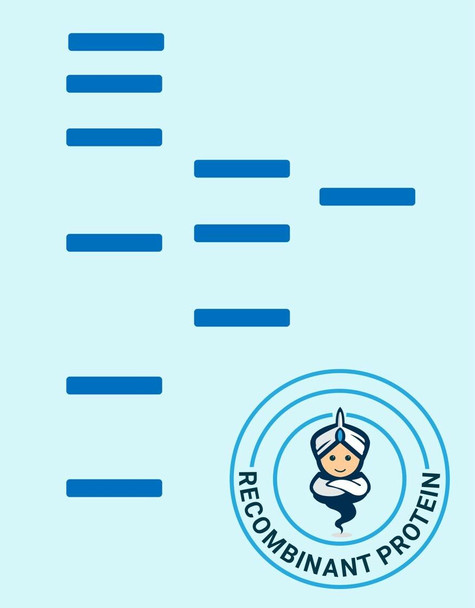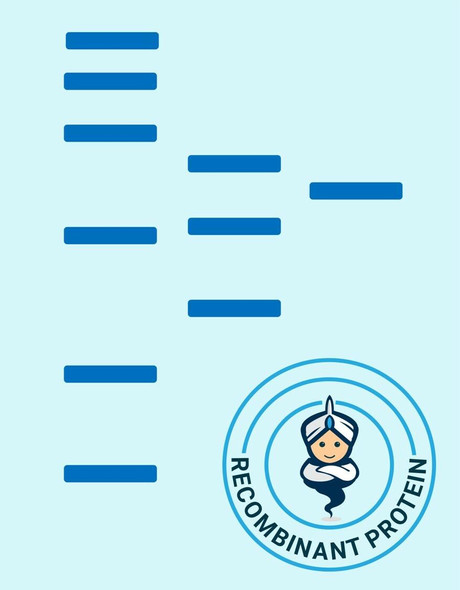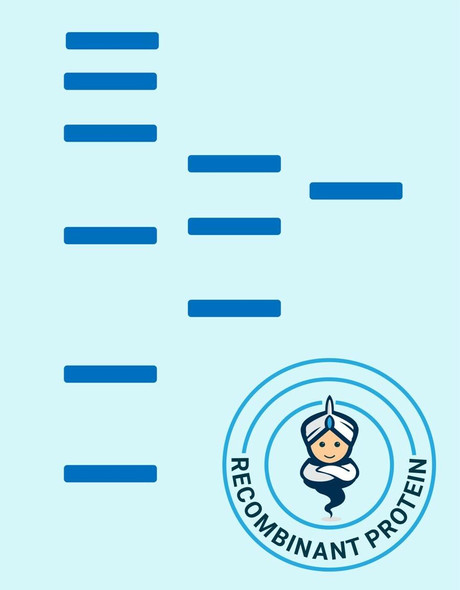Human BMP 4 Recombinant Protein (RPPB0096)
- SKU:
- RPPB0096
- Product Type:
- Recombinant Protein
- Species:
- Human
- Uniprot:
- P12644
- Research Area:
- Cytokines
Description
| Product Name: | Human BMP 4 Recombinant Protein |
| Product Code: | RPPB0096 |
| Size: | 10µg |
| Species: | Human |
| Target: | BMP 4 |
| Synonyms: | BMP4, ZYME, BMP2B, BMP2B1. |
| Source: | Escherichia Coli |
| Physical Appearance: | Sterile Filtered White lyophilized (freeze-dried) powder. |
| Formulation: | BMP-4 was lyophilized from a 0.2�m filtered concentrated (1mg/ml) solution in 20mM Na2CO3 buffer, pH 9.0. |
| Solubility: | It is recommended to reconstitute the lyophilized Bone Morphogenetic Protein-4 in sterile 18M-cm H2O not less than 100�g/ml, which can then be further diluted to other aqueous solutions. |
| Stability: | Lyophilized Bone Morphogenetic Protein-4 although stable at room temperature for 3 weeks, should be stored desiccated below -18°C. Upon reconstitution BMP4 should be stored at 4°C between 2-7 days and for future use below -18°C.For long term storage it is recommended to add a carrier protein (0.1% HSA or BSA).Please prevent freeze-thaw cycles. |
| Purity: | Greater than 95.0% as determined by:(a) Analysis by RP-HPLC.(b) Analysis by SDS-PAGE. |
| Amino Acid Sequence: | SPKHHSQRAR KKNKNCRRHS LYVDFSDVGW NDWIVAPPGY QAFYCHGDCP FPLADHLNST NHAIVQTLVN SVNSSIPKAC CVPTELSAIS MLYLDEYDKV VLKNYQEMVV EGCGCR |
The protein encoded by this gene is a member of the bone morphogenetic protein family which is part of the transforming growth factor-beta superfamily. The superfamily includes large families of growth and differentiation factors. Bone morphogenetic proteins were originally identified by an ability of demineralized bone extract to induce endochondral osteogenesis in vivo in an extraskeletal site. This particular family member plays an important role in the onset of endochondral bone formation in humans, and a reduction in expression has been associated with a variety of bone diseases, including the heritable disorder Fibrodysplasia Ossificans Progressiva. Alternative splicing in the 5' untranslated region of this gene has been described and three variants are described, all encoding an identical protein.
Bone Morphogenetic Protein-4 Human Recombinant produced in E.Coli is a monomeric, non-glycosylated, Polypeptide chain containing 116 amino acids and having a molecular mass of 13kDa. The BMP-4 is purified by proprietary chromatographic techniques.
| UniProt Protein Function: | BMP4: Induces cartilage and bone formation. Also act in mesoderm induction, tooth development, limb formation and fracture repair. Acts in concert with PTHLH/PTHRP to stimulate ductal outgrowth during embryonic mammary development and to inhibit hair follicle induction. Homodimer; disulfide-linked. Interacts with GREM2. Part of a complex consisting of TWSG1 and CHRD. Interacts with the serine proteases, HTRA1 and HTRA3; the interaction with either inhibits BMP4-mediated signaling. The HTRA protease activity is required for this inhibition. Interacts with SOSTDC1. Expressed in the lung and lower levels seen in the kidney. Present also in normal and neoplastic prostate tissues, and prostate cancer cell lines. Belongs to the TGF-beta family. |
| UniProt Protein Details: | Protein type:Secreted; Secreted, signal peptide Chromosomal Location of Human Ortholog: 14q22.2 Cellular Component: extracellular region; extracellular space Molecular Function:chemoattractant activity; cytokine activity; protein binding; transforming growth factor beta receptor binding Biological Process: activation of MAPKK activity; alveolus development; blood vessel endothelial cell proliferation during sprouting angiogenesis; BMP signaling pathway; branching morphogenesis of a tube; chondrocyte differentiation; common-partner SMAD protein phosphorylation; endochondral ossification; hemopoietic progenitor cell differentiation; intermediate mesodermal cell differentiation; kidney development; lymphoid progenitor cell differentiation; macrophage differentiation; mesonephros development; monocyte differentiation; negative regulation of apoptosis; negative regulation of cell cycle; negative regulation of cell proliferation; negative regulation of immature T cell proliferation in the thymus; negative regulation of MAP kinase activity; negative regulation of mitosis; negative regulation of myoblast differentiation; negative regulation of phosphorylation; negative regulation of striated muscle development; negative regulation of T cell differentiation in the thymus; negative regulation of transcription from RNA polymerase II promoter; negative regulation of transcription, DNA-dependent; odontogenesis; osteoblast differentiation; positive regulation of apoptosis; positive regulation of BMP signaling pathway; positive regulation of bone mineralization; positive regulation of cardiac muscle fiber development; positive regulation of collagen biosynthetic process; positive regulation of endothelial cell proliferation; positive regulation of epidermal cell differentiation; positive regulation of epithelial cell proliferation; positive regulation of ossification; positive regulation of osteoblast differentiation; positive regulation of protein amino acid phosphorylation; positive regulation of protein binding; positive regulation of smooth muscle cell proliferation; positive regulation of transcription from RNA polymerase II promoter; positive regulation of transcription, DNA-dependent; post-embryonic development; regulation of cell fate commitment; regulation of protein import into nucleus; smooth muscle development; smoothened signaling pathway; steroid hormone mediated signaling; telencephalon development; ureteric bud branching; ureteric bud development Disease: Microphthalmia, Syndromic 6; Orofacial Cleft 11 |
| NCBI Summary: | This gene encodes a secreted ligand of the TGF-beta (transforming growth factor-beta) superfamily of proteins. Ligands of this family bind various TGF-beta receptors leading to recruitment and activation of SMAD family transcription factors that regulate gene expression. The encoded preproprotein is proteolytically processed to generate each subunit of the disulfide-linked homodimer. This protein regulates heart development and adipogenesis. Mutations in this gene are associated with orofacial cleft and microphthalmia in human patients. The encoded protein may also be involved in the pathology of multiple cardiovascular diseases and human cancers. [provided by RefSeq, Jul 2016] |
| UniProt Code: | P12644 |
| NCBI GenInfo Identifier: | 115073 |
| NCBI Gene ID: | 652 |
| NCBI Accession: | P12644.1 |
| UniProt Secondary Accession: | P12644,Q9UM80, |
| UniProt Related Accession: | P12644 |
| Molecular Weight: | 47kDa |
| NCBI Full Name: | Bone morphogenetic protein 4 |
| NCBI Synonym Full Names: | bone morphogenetic protein 4 |
| NCBI Official Symbol: | BMP4�� |
| NCBI Official Synonym Symbols: | ZYME; BMP2B; OFC11; BMP2B1; MCOPS6�� |
| NCBI Protein Information: | bone morphogenetic protein 4 |
| UniProt Protein Name: | Bone morphogenetic protein 4 |
| UniProt Synonym Protein Names: | Bone morphogenetic protein 2B; BMP-2B |
| Protein Family: | Bone morphogenetic protein |
| UniProt Gene Name: | BMP4�� |










